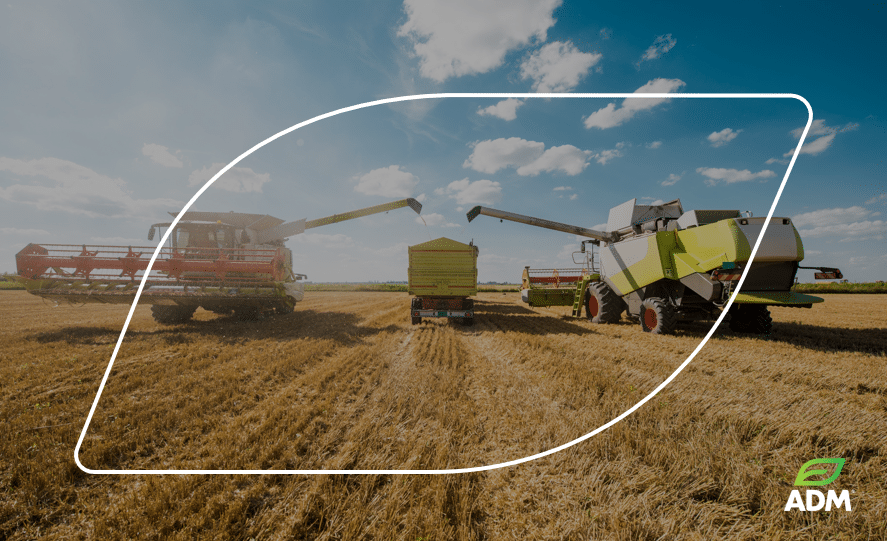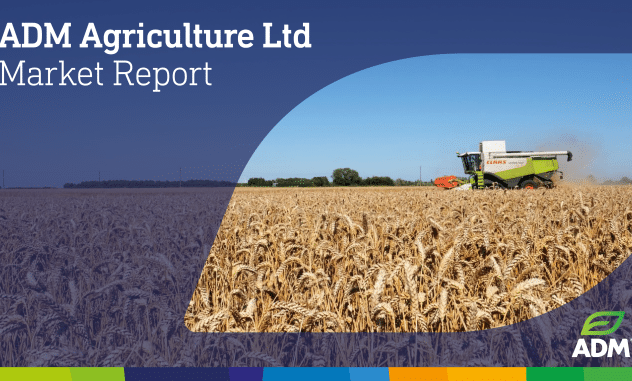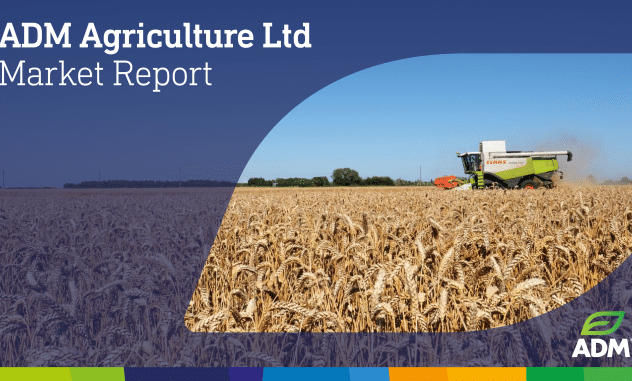WELCOME TO THE ADM AGRICULTURE WEEKLY MARKET REPORT
Wheat
- Global wheat markets continue to track lower, with recent support levels being assessed and broken through on all three major futures exchanges, CBOT, MATIF, and LIFFE.
- Markets hit lows on Wednesday with CBOT entering oversold territory, having traded below $6/bushel for September, a level that had been seen as a recent support.
- Unsurprisingly, this triggered a round of short covering but, with fund positions close to net short records, there is clearly an expectation that markets will continue to drift lower.
- Following on from the long weekend, London wheat traded £7/t weaker on Tuesday, following on from a drop on the Continent that we saw on Bank Holiday Monday.
- London wheat futures’ technical support at £183 for Nov was also broken through, trading to a low of £180 on Wednesday. The forecasted warm dry weather has not come to fruition this week, but crops continue to develop and most of the market expects the UK to have somewhere in the region of a 16 mln t crop.
- That would mean a huge exportable surplus, but a significant strengthening of sterling midweek, only pushes the UK further away from connecting with exports, adding to the heavy picture already painted. Domestic consumers remain bearish and fresh activity remains limited as a result.
- The corn market feels like it has now priced in an element of weather premium after three weeks of dry weather in parts of the US Midwest, but the outlook for more normal rainfall after 7 June has helped pressure markets lower.
- Without any real bullish story, we could see corn markets track movements in other grains short term. Planting progress in the US has reached 92%, in line with expectations and just above the year-ago pace and five-year average at 84%. The US crop was rated 69% good/excellent, just below the 73% this time last year.
- Overall, some significant technical support levels have been broken, albeit not sustained, and the market is now looking for a fresh direction. Fundamentally we continue to monitor the Russia-Ukraine conflict and what this may mean for the Black Sea grain corridor in the medium term, as well as some concerns over the dryness in the USA.
- Despite this, plentiful stocks in most of the world’s key exporters are growing well with no issues to report, so a greater reliance will be placed upon demand for any sustained price support.
Malting Barley
- Malting barley markets have stubbornly held their value, despite the continued push lower in futures. Farmers are still not engaging in the marketplace in any European origin which is helping to support values. Meanwhile, we have seen some brewer price fixing on the continent which has helped to bring demand to the FOB market.
- Dryness concerns in Scandinavia are adding concerns, however we believe it is too early to talk serious crop reductions.
- Crops in the UK have benefited again from improved UV exposure over the last few weeks; however, crop conditions are mixed following the cold/wet period following planting.
Feed Barley
- Feed barley markets have struggled over the last week as activity falls off a cliff.
- Most seem to have closed the book on old crop as we head into June, with the farmer and consumer almost totally out of the market.
- New crop is also rather inactive with thin farmer selling for another week. Despite this, prices keep pushing lower, feeling the pressure from the downward futures trend.
- Late rains in Spain have pared back some of the recent buying interest. However, domestic production for barley is still well down on the year, so we expect to see good import demand going forwards. But the UK is still missing out on demand to the growing programme out of the Black Sea.
Rapeseed
- A short week for most this week and month-end. US stocks were mixed pending the decision on the US debt ceiling. Energy markets continued to fall and attacks between Russia/Ukraine escalate.
- CBOT Soybeans lacked friends in recent weeks. Prices quickly fell to new contract lows following continued poor demand and better Brazilian crop expectations. In addition, U. plantings are nearly complete at 83% yesterday vs. 66% last week and the weather remains favourable into June. Whilst prices look overdone to the downside you certainly cannot rule out seeing cheaper levels.
- US prices remain a premium to South American beans. Yesterday it was rumoured that China had stepped in to buy another few cargoes from Brazil.
- Energy markets continue to drift lower; short-term concerns over the increase in covid cases in China which will be closely watched. President Xi Jinping called a meeting with top security officials to talk over “worst-case” scenarios which caused a risk-off approach to markets. Chinese manufacturing data was poor and US production is rumoured to have increased recently which weighs on prices. Veg oil prices naturally followed whilst soy-oil prices recovered some of the recent losses palm closed nearly 6% down yesterday. The Malaysian Palm Oil Board reported that its loss in production in 2024, due to effects of EL Nino, would not impact this year.
- Canadian canola prices saw a sharp downward correction this week. Better weather in Canada helped plantings advance to 65% complete vs the five-year average of 69%.
- Matif rapeseed followed a similar trend and closed sharply lower at the start of the week, prices recovered yesterday but still struggled to break €400. Similarly, to beans, the market continues to feel overdone to the downside but given the lack of product demand and large carryover this season then prices remain firmly in down trend.
Oats
- European oat markets have been impacted by the continued fall in wheat prices, although due to some inelastic demand prices have resisted a fall on a one-for-one basis.
- Spanish buyers have purchased parcels from both the Baltics and UK trading in recent weeks, but they are now targeting Jul and Aug positions.
- Milling oat demand is noticeably quiet with minimal activity being reported by western EU buyers. However, a large part of this demand normally takes place post-harvest once the new crop quality is known.
- Scandinavian sellers typically provide cover for Aug and Sept positions for the oat milling sector and, with some consumers carrying old crop stock, it is unsurprising to see limited demand right now for new crop.
- Dry weather forecasts for large areas of the EU oat growing region are a concern for developing spring crops, with minimal precipitation in the forecast for Scandinavia.
- Here in the UK, sunshine and warmer temperatures will aid the development of the winter oat crops. Spring oats were drilled later than normal so are vulnerable if they cannot access the moisture which is available deeper in the soil.
- Demand for both the feed and milling oats has reduced in 2022/23 season. However, the record pace of exports (160,000t vs 123,000t last year and 70,000t five-year average) will help counter the 113,000t drop in domestic demand as reported by the AHDB.
- Bottom line, demand for old crop in Europe has largely been limited to Spain and new crop remains large untraded, therefore the quality of the UK crop is going to be crucial in determining our price direction.
Pulses
- Peas
- Old crop looks to be done with little to no farmer selling on anything left on farm. This coincides with the feed pea market looking covered domestically until next season. If anyone does have peas remaining on farm, we still have options to move them into Long Sutton so please contact your farm trader!
- New-crop wise, the peas in the ground do look in good stead despite some early weather concerns at the beginning of May. I recommend to anyone who has grown peas to watch PGRO’s latest video surrounding pea moth to get the best out of your crop.
- 2024 pea buybacks are looking to be released through June so please keep an eye out.
- Beans
- Old crop beans are stable week on week, we remain keen buyers of any old crop feed beans should you have any on farm.
- New crop beans still track the Nov 23 London wheat futures but, despite relatively decent past seasonal levels, there is very little farmer selling, despite the crop in the ground looking good at this early stage
- It is a bit dry over in the Baltics which is a potential red flag. Crop production in Australia could also be reduced due to the risk of El Nino, but the country’s large carryout from 2022 should not result in too much movement in markets.
Seed
- When you are considering rapeseed this year, why not investigate drilling a companion crop alongside it.
- Our range of companion crops include a mix of fenugreek, berseem clover and buckwheat. Each component providing a different quality to help aid establishment of the oilseed rape.
- Find out more about companion and cover cropping on our YouTube channel – https://youtu.be/MpKIsgDWGkc
- Our game maize is extremely limited so please direct any enquiries to your ADM farm trader as soon as possible.
Fertiliser
- The EU’s urea and ammonia tariff suspension put in place towards the end of January remains the key focus for the region’s nitrogen manufacturers and traders.
- The 6.5% tariff was suspended for 6 months on urea and ammonia from other origins. If the tariff is re-imposed there could be some support for the 46% product in Europe as alternative origins for the product become more expensive.
- India has tendered for circa 800,000t of urea. Prompt shipment is required for this tender and market sources indicate that discussions at Egyptian ports could be aligning themselves to service some of this market.
- UK AN prices remain unavailable at present and there is circa £10/t increase on imported AN offer for the summer movement months whilst CF is out of the market.
- Liquid UAN terms have been issued, with similar prices to the UK AN price. Foliar products for this year are also available and demand is picking up as we near the time when product is required on farm.
- Current uptake levels across all nitrogen products appears to be lower than last year, indicating that a significant uptick in demand could surface through or post-harvest as natural gas prices traditionally rise into winter.
- Phosphate values are slightly lower week-on-week, whilst potash remains relatively stable. Direction is being sought as straight MOP, TSP and DAP sales are muted at present.
| £/€ | £/$ | €/$ |
|---|---|---|
| 1.164 | 1.25 | 0.937 |
| Feed Barley £ | Wheat £ | Beans £ | Oilseed Rape £ | |
|---|---|---|---|---|
| Jun 2023 | 150-160 | 180-186 | 244-248 | 315-320 |
NB: Prices quoted are indicative only at the time of going to press and subject to location and quality.
“Although ADM Agriculture take steps to ensure the validity of all information contained within the ADM Agriculture Market Report, it makes no warranty as to the accuracy or completeness of such information. ADM Agriculture will have no liability or responsibility for the information or any action or failure to act based upon such information.”
ADM Agriculture cannot accept liability arising from errors or omissions in this publication.
ADM Agriculture trade under AIC contracts which incorporate the arbitration clause.
Terms and Conditions of Purchase.
On every occasion, without exception, grain and pulses will be bought by incorporating by reference the terms & conditions of the AIC No.1 Grain and Peas or Beans contract applicable on the date of the transaction. Also, we will always, and without exception, buy oilseed rape and linseed by incorporating by reference the terms & conditions of the respective terms of the FOSFA 26A and the FOSFA 9A contracts applicable on the date of the transaction. It is a condition of all such transactions that the seller is deemed to know, accept and understand the terms and conditions of each of the above contracts.



